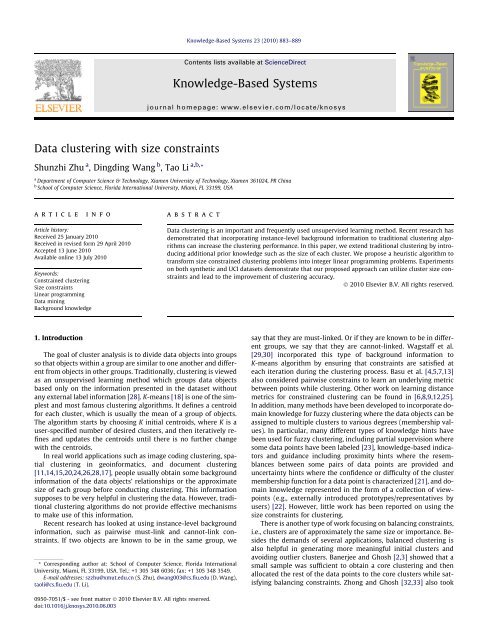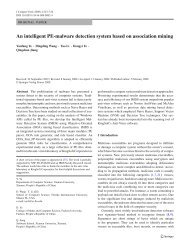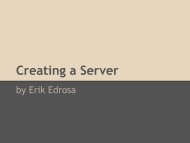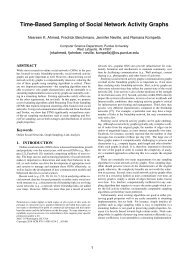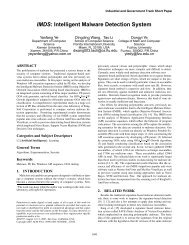Data clustering with size constraints - Florida International University
Data clustering with size constraints - Florida International University
Data clustering with size constraints - Florida International University
Create successful ePaper yourself
Turn your PDF publications into a flip-book with our unique Google optimized e-Paper software.
Knowledge-Based Systems 23 (2010) 883–889<br />
Contents lists available at ScienceDirect<br />
Knowledge-Based Systems<br />
journal homepage: www.elsevier.com/locate/knosys<br />
<strong>Data</strong> <strong>clustering</strong> <strong>with</strong> <strong>size</strong> <strong>constraints</strong><br />
Shunzhi Zhu a , Dingding Wang b , Tao Li a,b, *<br />
a Department of Computer Science & Technology, Xiamen <strong>University</strong> of Technology, Xiamen 361024, PR China<br />
b School of Computer Science, <strong>Florida</strong> <strong>International</strong> <strong>University</strong>, Miami, FL 33199, USA<br />
article<br />
info<br />
abstract<br />
Article history:<br />
Received 25 January 2010<br />
Received in revised form 29 April 2010<br />
Accepted 13 June 2010<br />
Available online 13 July 2010<br />
Keywords:<br />
Constrained <strong>clustering</strong><br />
Size <strong>constraints</strong><br />
Linear programming<br />
<strong>Data</strong> mining<br />
Background knowledge<br />
<strong>Data</strong> <strong>clustering</strong> is an important and frequently used unsupervised learning method. Recent research has<br />
demonstrated that incorporating instance-level background information to traditional <strong>clustering</strong> algorithms<br />
can increase the <strong>clustering</strong> performance. In this paper, we extend traditional <strong>clustering</strong> by introducing<br />
additional prior knowledge such as the <strong>size</strong> of each cluster. We propose a heuristic algorithm to<br />
transform <strong>size</strong> constrained <strong>clustering</strong> problems into integer linear programming problems. Experiments<br />
on both synthetic and UCI datasets demonstrate that our proposed approach can utilize cluster <strong>size</strong> <strong>constraints</strong><br />
and lead to the improvement of <strong>clustering</strong> accuracy.<br />
Ó 2010 Elsevier B.V. All rights reserved.<br />
1. Introduction<br />
The goal of cluster analysis is to divide data objects into groups<br />
so that objects <strong>with</strong>in a group are similar to one another and different<br />
from objects in other groups. Traditionally, <strong>clustering</strong> is viewed<br />
as an unsupervised learning method which groups data objects<br />
based only on the information presented in the dataset <strong>with</strong>out<br />
any external label information [28]. K-means [18] is one of the simplest<br />
and most famous <strong>clustering</strong> algorithms. It defines a centroid<br />
for each cluster, which is usually the mean of a group of objects.<br />
The algorithm starts by choosing K initial centroids, where K is a<br />
user-specified number of desired clusters, and then iteratively refines<br />
and updates the centroids until there is no further change<br />
<strong>with</strong> the centroids.<br />
In real world applications such as image coding <strong>clustering</strong>, spatial<br />
<strong>clustering</strong> in geoinformatics, and document <strong>clustering</strong><br />
[11,14,15,20,24,26,28,17], people usually obtain some background<br />
information of the data objects’ relationships or the approximate<br />
<strong>size</strong> of each group before conducting <strong>clustering</strong>. This information<br />
supposes to be very helpful in <strong>clustering</strong> the data. However, traditional<br />
<strong>clustering</strong> algorithms do not provide effective mechanisms<br />
to make use of this information.<br />
Recent research has looked at using instance-level background<br />
information, such as pairwise must-link and cannot-link <strong>constraints</strong>.<br />
If two objects are known to be in the same group, we<br />
* Corresponding author at: School of Computer Science, <strong>Florida</strong> <strong>International</strong><br />
<strong>University</strong>, Miami, FL 33199, USA. Tel.: +1 305 348 6036; fax: +1 305 348 3549.<br />
E-mail addresses: szzhu@xmut.edu.cn (S. Zhu), dwang003@cs.fiu.edu (D. Wang),<br />
taoli@cs.fiu.edu (T. Li).<br />
say that they are must-linked. Or if they are known to be in different<br />
groups, we say that they are cannot-linked. Wagstaff et al.<br />
[29,30] incorporated this type of background information to<br />
K-means algorithm by ensuring that <strong>constraints</strong> are satisfied at<br />
each iteration during the <strong>clustering</strong> process. Basu et al. [4,5,7,13]<br />
also considered pairwise constrains to learn an underlying metric<br />
between points while <strong>clustering</strong>. Other work on learning distance<br />
metrics for constrained <strong>clustering</strong> can be found in [6,8,9,12,25].<br />
In addition, many methods have been developed to incorporate domain<br />
knowledge for fuzzy <strong>clustering</strong> where the data objects can be<br />
assigned to multiple clusters to various degrees (membership values).<br />
In particular, many different types of knowledge hints have<br />
been used for fuzzy <strong>clustering</strong>, including partial supervision where<br />
some data points have been labeled [23], knowledge-based indicators<br />
and guidance including proximity hints where the resemblances<br />
between some pairs of data points are provided and<br />
uncertainty hints where the confidence or difficulty of the cluster<br />
membership function for a data point is characterized [21], and domain<br />
knowledge represented in the form of a collection of viewpoints<br />
(e.g., externally introduced prototypes/representatives by<br />
users) [22]. However, little work has been reported on using the<br />
<strong>size</strong> <strong>constraints</strong> for <strong>clustering</strong>.<br />
There is another type of work focusing on balancing <strong>constraints</strong>,<br />
i.e., clusters are of approximately the same <strong>size</strong> or importance. Besides<br />
the demands of several applications, balanced <strong>clustering</strong> is<br />
also helpful in generating more meaningful initial clusters and<br />
avoiding outlier clusters. Banerjee and Ghosh [2,3] showed that a<br />
small sample was sufficient to obtain a core <strong>clustering</strong> and then<br />
allocated the rest of the data points to the core clusters while satisfying<br />
balancing <strong>constraints</strong>. Zhong and Ghosh [32,33] also took<br />
0950-7051/$ - see front matter Ó 2010 Elsevier B.V. All rights reserved.<br />
doi:10.1016/j.knosys.2010.06.003
884 S. Zhu et al. / Knowledge-Based Systems 23 (2010) 883–889<br />
balancing <strong>constraints</strong> into consideration and developed an iterative<br />
bipartitioning heuristic for sample assignment. All of the effort<br />
has illustrated that utilizing background knowledge can improve<br />
<strong>clustering</strong> performance in accuracy and scalability.<br />
Balancing <strong>constraints</strong> can be viewed as a special case of <strong>size</strong><br />
<strong>constraints</strong> where all the clusters have the same <strong>size</strong>. Several real<br />
life <strong>clustering</strong> applications require the clusters that have fixed <strong>size</strong>,<br />
but not necessarily the equal <strong>size</strong> for all the clusters. For example, a<br />
typical task in marketing study is customer segmentation where<br />
customers are divided into different groups where a particular<br />
sales team or a specific amount of marketing dollars is allocated<br />
to each group. If each sales team is of different <strong>size</strong> or the allocation<br />
of marketing dollars is of different amount, then the customer segmentation<br />
problem becomes a data <strong>clustering</strong> problem <strong>with</strong> <strong>size</strong><br />
<strong>constraints</strong>. Similarly, a job scheduling problem, where a number<br />
of jobs are assigned to different machines/processes, can be modeled<br />
as a data <strong>clustering</strong> problem <strong>with</strong> <strong>size</strong> <strong>constraints</strong> if different<br />
machines/processes have different capacities. Many other problems<br />
such as document <strong>clustering</strong> where each cluster has a fixed<br />
storage space and spatial <strong>clustering</strong> where each cluster has a specific<br />
number of spatial objects can be naturally formulated as data<br />
<strong>clustering</strong> problems <strong>with</strong> <strong>size</strong> <strong>constraints</strong>.<br />
In this paper, we extend balancing <strong>constraints</strong> to <strong>size</strong> <strong>constraints</strong>,<br />
i.e., based on the prior knowledge of the distribution of<br />
the data, we assign the <strong>size</strong> of each cluster and try to find a partition<br />
which satisfies the <strong>size</strong> <strong>constraints</strong>. We also present some case<br />
studies of considering <strong>size</strong> <strong>constraints</strong> and instance-level cannotlink<br />
<strong>constraints</strong> simultaneously. We propose a heuristic procedure<br />
to solve these constrained <strong>clustering</strong> problems by transforming<br />
them into integer linear programming optimization problems.<br />
Experiments on synthetic and UCI datasets demonstrate the<br />
improvement of <strong>clustering</strong> accuracy using our proposed methods.<br />
The rest of the paper is organized as follows. In Section 2, we<br />
present the problem formulation. In Section 3, we describe our<br />
heuristic procedure to produce a near-optimal solution. In Section<br />
4, we present the experimental results. Finally, in Section 5, we<br />
conclude our work and discuss the future work.<br />
2. Problem formulation<br />
In the problem of <strong>clustering</strong> <strong>with</strong> <strong>size</strong> <strong>constraints</strong>, we have the<br />
prior knowledge of the number of objects in each cluster. And we<br />
can also obtain the partition result of any traditional <strong>clustering</strong> algorithm,<br />
such as K-means. Then the problem is formulated as follows.<br />
Given a data set of n objects, let A =(A 1 ,A 2 ,...,A p ) be a known<br />
partition <strong>with</strong> p clusters, and NumA =(na 1 ,na 2 ,...,na p ) be the number<br />
of objects in each cluster in A. We look for another partition<br />
B =(B 1 ,B 2 ,...,B p ) which maximizes the agreement between A and<br />
B, and NumB =(nb 1 ,nb 2 ,...,nb p ) represents the <strong>size</strong> <strong>constraints</strong>,<br />
i.e., the number of objects in each cluster in B.<br />
A and B can be represented as n p partition matrices. Each row<br />
of the matrix represents an object, and each column is for a cluster.<br />
a ij =1orb ij = 1 when object i belongs to cluster j in partition A or B.<br />
A can be represented as<br />
2<br />
3<br />
1 0 0 ... 0 0 0<br />
...<br />
...<br />
1 0 0 ... 0 0 0<br />
0 1 0 ... 0 0 0<br />
A ¼<br />
; ð1Þ<br />
0 1 0 ... 0 0 0<br />
...<br />
...<br />
6<br />
7<br />
4 0 0 0 ... 0 0 15<br />
0 0 0 ... 0 0 1<br />
where<br />
X n<br />
i¼1<br />
and<br />
X p<br />
j¼1<br />
a ij ¼ na j ; j ¼ 1; ...; p;<br />
a ij ¼ 1; i ¼ 1; ...; n:<br />
It is easy to see that AA T is an n n matrix <strong>with</strong> the values<br />
<br />
ðAA T 1; i and j are in the same group in A;<br />
Þ ij<br />
¼<br />
0; otherwise:<br />
The problem is to find another partition B, which minimizes<br />
kAA T BB T k;<br />
satisfying P n<br />
i¼1 b ij ¼ nb j ; j ¼ 1; ...; p, and P p<br />
j¼1 b ij ¼ 1; i ¼ 1; ...; n.<br />
The problem is similar to finding a partition which maximizes<br />
its agreement <strong>with</strong> another known partition [19].<br />
3. Solution of <strong>size</strong> constrained <strong>clustering</strong><br />
Now, the original <strong>size</strong> constrained <strong>clustering</strong> problem becomes<br />
an optimization problem. Here, we propose a heuristic algorithm<br />
to efficiently find the solution.<br />
3.1. The heuristic procedure<br />
To solve the problem stated in the previous section, first of all,<br />
we define<br />
D a ¼ diagðna 1 ; na 2 ; ...; na p Þ;<br />
and<br />
D b ¼ diagðnb 1 ; nb 2 ; ...; nb p Þ:<br />
Let<br />
2<br />
a 1j<br />
a 2j<br />
U j ¼ p<br />
1 ...<br />
ffiffiffiffiffiffiffi<br />
na j<br />
...<br />
; j ¼ 1; ...; p; ð5Þ<br />
6 7<br />
4 ... 5<br />
a nj<br />
3<br />
where each a ij 2 {0,1}, and<br />
X<br />
a ij ¼ na j ; j ¼ 1; ...; p;<br />
i<br />
X<br />
a ij ¼ 1; i ¼ 1; ...; n:<br />
j<br />
Then, we can see that actually U = A(D a ) 1/2 . In the same way, let<br />
2 3<br />
b 1j<br />
b 2j<br />
V j ¼ p<br />
1 ...<br />
ffiffiffiffiffiffiffi<br />
nb j<br />
...<br />
; j ¼ 1; ...; p; ð6Þ<br />
6 7<br />
4 ... 5<br />
b nj<br />
where each b ij 2 {0,1}, and<br />
X<br />
b ij ¼ nb j ; j ¼ 1; ...; p;<br />
i<br />
X<br />
b ij ¼ 1; i ¼ 1; ...; n:<br />
j<br />
Similarly, V = B(D b ) 1/2 .<br />
ð2Þ<br />
ð3Þ<br />
ð4Þ
S. Zhu et al. / Knowledge-Based Systems 23 (2010) 883–889 885<br />
Then, we can write<br />
AA T ¼ UD a TU;<br />
and<br />
BB T ¼ UD b TU:<br />
Thus<br />
kAA T BB T k 2 ¼kUD a U T VD b V T k 2 ¼kD a U T VD b ðU T VÞ T k 2 : ð9Þ<br />
If there exists V, so that<br />
2<br />
3<br />
1 0 0 ... 0 0 0<br />
0 1 0 ... 0 0 0<br />
0 0 1 ... 0 0 0<br />
U T ...<br />
V ¼ J ¼<br />
; ð10Þ<br />
...<br />
0 0 0 ... 1 0 0<br />
6<br />
7<br />
4 0 0 0 ... 0 1 05<br />
0 0 0 ... 0 0 1<br />
then we can get<br />
kAA T BB T k 2 ¼kD a D b k 2 : ð11Þ<br />
B would be the best approximation of A, and at the same time<br />
satisfies the <strong>size</strong> <strong>constraints</strong>. However, it is difficult to find such<br />
a V so that U T V = J. Therefore, we would like to choose V to minimize<br />
kU T V Jk. Note that<br />
kU T V Jk ¼2p 2 Xn<br />
j¼1<br />
i¼1<br />
X p<br />
j¼1<br />
u ij v ij ;<br />
ð7Þ<br />
ð8Þ<br />
ð12Þ<br />
where u ij and v ij are the components of the vectors U j and V j , respectively.<br />
Thus, this <strong>size</strong> constrained <strong>clustering</strong> can be transformed to<br />
the following linear programming problem:<br />
" #<br />
X p 1 X n<br />
minimize pffiffiffiffiffiffiffiffiffiffiffiffiffi<br />
a ij b ij ; ð13Þ<br />
na j nb j<br />
where<br />
X<br />
b ij ¼ nb j ; j ¼ 1; ...; p;<br />
i<br />
X<br />
b ij ¼ 1; i ¼ 1; ...; n;<br />
j<br />
and<br />
b ij 2f0; 1g:<br />
i¼1<br />
This is a typical binary integer linear programming problem which<br />
can easily be solved by any existing solver.<br />
In summary, the heuristic procedure has two steps:<br />
Apply an efficient and effective traditional or instance-level<br />
constrained <strong>clustering</strong> algorithm to the data and<br />
Create <strong>size</strong> <strong>constraints</strong> based on the prior knowledge of the<br />
data, and then transform the <strong>size</strong> constrained <strong>clustering</strong> to a<br />
binary integer linear programming problem by the approach<br />
described above.<br />
3.2. Discussion<br />
One thing worth mentioning is that if we use any other<br />
instance-level constrained <strong>clustering</strong> algorithm as the base algorithm<br />
in the first step, some <strong>constraints</strong> may be violated in the final<br />
results. Actually, instance-level <strong>constraints</strong> such as cannot-link<br />
<strong>constraints</strong> can be incorporated into our transformed linear programming<br />
as an inequality constraint. For example, if the object<br />
k and object l cannot be in the same cluster, the constraint can<br />
be presented as:<br />
b kj þ b lj 6 1; j ¼ 1; ...; p: ð14Þ<br />
Therefore, our approach can either (1) take advantage of other<br />
instance-level constrained <strong>clustering</strong> algorithms and add the <strong>size</strong><br />
prior knowledge to them or (2) directly solve the constrained <strong>clustering</strong><br />
problem based on the traditional <strong>clustering</strong> methods.<br />
As described in Section 1, in many real life <strong>clustering</strong> applications,<br />
the <strong>size</strong>s of each cluster are known in advance. Using the <strong>size</strong><br />
<strong>constraints</strong> would help improve the <strong>clustering</strong> performance. In<br />
addition to the application requirements, <strong>clustering</strong> <strong>with</strong> <strong>size</strong> <strong>constraints</strong><br />
is also helpful to decrease the sensitivity of random initialization<br />
in <strong>clustering</strong> process and to avoid the generation of outlier<br />
clusters or highly imbalanced clusters [33]. Note that in many<br />
cases, however, the prior knowledge about the exact <strong>size</strong> of the<br />
clusters might be difficult to acquire. In these cases, we can consider<br />
the relaxation of the <strong>size</strong> <strong>constraints</strong>. Instead of specifying<br />
the exact <strong>size</strong> of each cluster, our method also allows for the<br />
approximate <strong>size</strong> range of a cluster. For example, in some applications,<br />
the cluster <strong>size</strong> cannot exceed a threshold t, then this constraint<br />
can be written as:<br />
X<br />
b ij 6 t; j ¼ 1; ...; p;<br />
i<br />
and<br />
X<br />
b ij ¼ 1; i ¼ 1; ...; n:<br />
j<br />
Some experiments on the relaxation of <strong>size</strong> <strong>constraints</strong> are presented<br />
in Section 4.4.3. Note that a special case is the balancing constraint<br />
where we can require the <strong>size</strong> of each cluster is roughly the<br />
same.<br />
4. Experimental evaluation<br />
In this section, we conduct experiments to evaluate the performance<br />
of our proposed approach. First of all, we look at a case<br />
Table 1<br />
<strong>Data</strong> sets from UCI.<br />
<strong>Data</strong>set Number of objects Number of classes Cluster <strong>size</strong><br />
Iris 150 3 50, 50, 50<br />
Wine 178 3 71, 59, 48<br />
Balance scale 625 3 288, 288, 49<br />
Ionosphere 351 2 226, 125<br />
Table 2<br />
Comparisons <strong>with</strong> K-means algorithm. Remark: KM denotes the K-means algorithm,<br />
SC represents our heuristic <strong>size</strong> constrained <strong>clustering</strong> approach, Acc stands for<br />
accuracy, and Ent is for entropy.<br />
<strong>Data</strong> Algo Acc Ent ARI NMI<br />
Iris KM 0.8133 0.2852 0.5913 0.6402<br />
SC 0.8467 0.2559 0.6416 0.6750<br />
Wine KM 0.7022 0.4477 0.3711 0.4288<br />
SC 0.7079 0.4400 0.3863 0.4383<br />
Balance scale KM 0.4976 0.7182 0.1186 0.0742<br />
SC 0.5248 0.7020 0.1389 0.0931<br />
Ionosphere KM 0.7123 0.3321 0.3634 0.2599<br />
SC 0.8034 0.3534 0.4056 0.2926
886 S. Zhu et al. / Knowledge-Based Systems 23 (2010) 883–889<br />
study to test the feasibility of our method. We then introduce the<br />
datasets and evaluation metrics used in our experiments. Finally,<br />
the experimental results on different datasets are presented and<br />
discussed.<br />
4.1. A case study on feasibility<br />
First of all, we use a very simple synthetic data set to illustrate<br />
the feasibility of our approach. In particular, the simple example<br />
demonstrates the importance of the <strong>size</strong> constrained <strong>clustering</strong><br />
problem.<br />
Given data X which contains six objects and each object has six<br />
attributes. We can write X as the following 6 6 matrix, in which<br />
each row represents an object and each column represents an attribute.<br />
Formally,<br />
2<br />
3<br />
1 1 1 1 1 1<br />
1 1 1 1 1 0<br />
1 1 1 1 0 0<br />
X ¼<br />
1 0 1 1 0 0<br />
:<br />
6<br />
7<br />
4 0 0 1 0 0 15<br />
0 0 0 0 0 0<br />
The class labels for the data are<br />
2 3<br />
1<br />
1<br />
1<br />
ClassLabel ¼<br />
2<br />
;<br />
6 7<br />
4 2 5<br />
2<br />
which means that there are two groups. The first three objects are<br />
in one group and the rest three are in another. The traditional<br />
K-means algorithm groups the first two objects together and the<br />
rest four in another group. If we know that the <strong>size</strong> of each cluster<br />
should be three, then using our heuristic approach, the <strong>clustering</strong><br />
results would be the same as the ground truth.<br />
This simple case study demonstrates that if we take advantage<br />
of <strong>size</strong> prior knowledge, the performance of <strong>clustering</strong> can be optimized,<br />
especially when in the case that there exist some marginal<br />
objects.<br />
4.2. Experimental datasets<br />
In order to evaluate the effectiveness of our heuristic approach,<br />
we use four UCI datasets to conduct <strong>size</strong> constrained <strong>clustering</strong>.<br />
The characteristics of the datasets are summarized in Table 1 and<br />
more description of the datasets can be found in [1].<br />
4.3. Evaluation measures<br />
To measure the <strong>clustering</strong> performance, we consider four measures<br />
including accuracy, adjusted rand index (ARI), normalized<br />
mutual information (NMI), and entropy. These measures are briefly<br />
described below.<br />
Accuracy discovers the relationship between each cluster and<br />
class which is the ground truth. It sums up the total matching<br />
degree between all pairs of clusters and classes [16]. Accuracy<br />
can be represented as:<br />
Accuracy ¼ Max<br />
X !,<br />
TðC k ; L m Þ N; ð15Þ<br />
C k ;L m<br />
where C k denotes the kth cluster, and L m is the mth class.<br />
T(C k ,L m ) is the number of entities which belong to class m are assigned<br />
to cluster k. Accuracy computes the maximum sum of<br />
K−means<br />
SC<br />
1<br />
Iris<br />
0.8<br />
Wine<br />
0.8<br />
0.6<br />
0.6<br />
0.4<br />
0.4<br />
0.2<br />
0.2<br />
0<br />
Acc Ent ARI NMI<br />
0<br />
Acc Ent ARI NMI<br />
0.8<br />
Balance Scale<br />
1<br />
Ionosphere<br />
0.6<br />
0.8<br />
0.6<br />
0.4<br />
0.4<br />
0.2<br />
0.2<br />
0<br />
Acc Ent ARI NMI<br />
0<br />
Acc Ent ARI NMI<br />
Fig. 1. Comparisons <strong>with</strong> K-means. Remark: SC represents our heuristic <strong>size</strong> constrained <strong>clustering</strong> approach, Acc stands for accuracy, and Ent is for entropy.
S. Zhu et al. / Knowledge-Based Systems 23 (2010) 883–889 887<br />
T(C k ,L m ) for all pairs of clusters and classes, and there is no overlap<br />
among these pairs. It is obvious that greater the accuracy,<br />
better the <strong>clustering</strong> performance.<br />
ARI [10] measures the agreements between the <strong>clustering</strong> and<br />
the partition by class labels. It is defined as the number of pairs<br />
of objects which are both placed in the same cluster and the<br />
same class, or both in different clusters and different classes,<br />
divided by the total number of objects. ARI is set between<br />
[0,1], and the higher the ARI, the more the resemblance<br />
between the <strong>clustering</strong> results and the labels.<br />
NMI [27] measures the amount of statistical information shared<br />
by two random variables representing cluster assignment and<br />
Table 3<br />
Comparisons <strong>with</strong> MPCK-means algorithm. Remark: MPC is MPCK-means algorithm,<br />
ISC1 represents our first way to incorporate both <strong>size</strong> and instance-level <strong>constraints</strong>,<br />
ISC2 represents our second way to do so, Acc stands for accuracy, and Ent is for<br />
entropy.<br />
<strong>Data</strong> Algo Acc Ent ARI NMI<br />
Iris MPC 0.8600 0.2399 0.6648 0.6933<br />
ISC1 0.8933 0.1830 0.7302 0.7582<br />
ISC2 0.8867 0.1971 0.7163 0.7419<br />
Wine MPC 0.9101 0.2199 0.7498 0.7087<br />
ISC1 0.9494 0.1401 0.8516 0.8267<br />
ISC2 0.9157 0.2282 0.7631 0.7205<br />
Balance scale MPC 0.5680 0.6243 0.0760 0.0527<br />
ISC1 0.6112 0.5823 0.1414 0.1165<br />
ISC2 0.6240 0.5973 0.1439 0.0895<br />
Ionosphere MPC 0.8148 0.3380 0.3910 0.2800<br />
ISC1 0.8177 0.3358 0.3984 0.2868<br />
ISC2 0.8205 0.3321 0.4056 0.2926<br />
underlying class label. Suppose entry n ij denotes the amount<br />
of data items belonging to cluster i and class j. NMI is computed<br />
as:<br />
P c P k n ij<br />
i¼1 j¼1 n<br />
NMI ¼<br />
log n ijn<br />
r<br />
n i nj<br />
ffiffiffiffiffiffiffiffiffiffiffiffiffiffiffiffiffiffiffiffiffiffiffiffiffiffiffiffiffiffiffiffiffiffiffiffiffiffiffiffiffiffiffiffiffiffiffiffiffiffiffiffiffiffiffiffiffiffiffiffiffiffiffiffiffiffiffi ; ð16Þ<br />
P c<br />
i¼1<br />
n i<br />
log <br />
n P<br />
i k<br />
n n j¼1<br />
n j<br />
n<br />
log n j<br />
n<br />
where n i ¼ P k<br />
j¼1 n ij; n j ¼ P c<br />
i¼1 n ij; n; c; k denote the total number<br />
of data objects, the number of clusters, and the number of classes,<br />
respectively. Based on our prior knowledge on the number of classes,<br />
usually, we set the number of clusters equal to the true number<br />
of classes, i.e., c = k.<br />
Entropy measures how classes are distributed on various clusters.<br />
In general, the smaller the entropy value, the better the<br />
<strong>clustering</strong> quality is. More details on the purity and entropy<br />
measures can be found in [31].<br />
4.4. Results and discussions<br />
Here, we conduct three sets of experiments to compare our<br />
proposed approach <strong>with</strong> both traditional K-means algorithm and<br />
instance-level constrained MPCK-means algorithm [7]. We also<br />
evaluate the flexibility of our approach to deal <strong>with</strong> the approximate<br />
<strong>size</strong> range <strong>constraints</strong> instead of exact cluster <strong>size</strong><br />
<strong>constraints</strong>.<br />
4.4.1. Comparisons <strong>with</strong> K-means<br />
The first set of experiments evaluates the effectiveness of our<br />
proposed heuristic approach by using K-means as the base algorithm<br />
in the first step of our approach, and comparing our results<br />
<br />
MPC ISC1 ISC2<br />
1<br />
Iris<br />
1<br />
Wine<br />
0.8<br />
0.8<br />
0.6<br />
0.6<br />
0.4<br />
0.4<br />
0.2<br />
0.2<br />
0<br />
Acc Ent ARI NMI<br />
0<br />
Acc Ent ARI NMI<br />
0.7<br />
Balance Scale<br />
1<br />
Ionosphere<br />
0.6<br />
0.5<br />
0.8<br />
0.4<br />
0.6<br />
0.3<br />
0.4<br />
0.2<br />
0.1<br />
0.2<br />
0<br />
Acc Ent ARI NMI<br />
0<br />
Acc Ent ARI NMI<br />
Fig. 2. Comparisons <strong>with</strong> MPCK-means. Remark: MPC is MPCK-means algorithm, ISC1 represents our first way to incorporate both <strong>size</strong> and instance-level <strong>constraints</strong>, ISC2<br />
represents our second way to do so, Acc stands for accuracy, and Ent is for entropy.
888 S. Zhu et al. / Knowledge-Based Systems 23 (2010) 883–889<br />
<strong>with</strong> the results of traditional K-means algorithm. Table 2 and<br />
Fig. 1 illustrate the evaluation results of our heuristic <strong>size</strong> constrained<br />
<strong>clustering</strong> using the four measures which are introduced<br />
in Section 4.3.<br />
From Table 2 and Fig. 1, we can clearly observe that the <strong>clustering</strong><br />
performance is enhanced by incorporating <strong>size</strong> <strong>constraints</strong> into<br />
K-means using our approach.<br />
4.4.2. Comparisons <strong>with</strong> MPCK-means<br />
The second set of experiments compares our approach <strong>with</strong><br />
MPCK-means algorithm [7], which considers instance-level <strong>constraints</strong>.<br />
We incorporate both <strong>size</strong> <strong>constraints</strong> and cannot-link <strong>constraints</strong><br />
into our approach in the following two ways: (1) use<br />
MPCK-means as the base algorithm in the first step of our approach,<br />
and in the second step, <strong>size</strong> <strong>constraints</strong> are taken into consideration;<br />
(2) use K-means as the base algorithm, and write<br />
cannot-link <strong>constraints</strong> in the form of inequality <strong>constraints</strong> of<br />
the linear programming in the second step of our approach. Fifty<br />
pairs of cannot-link <strong>constraints</strong> are generated randomly for each<br />
datasets, and the experimental results are shown in Table 3<br />
and Fig. 2.<br />
The results of this set of experiments are interesting. When we<br />
incorporate the <strong>size</strong> <strong>constraints</strong> into MPCK-means algorithm, we<br />
cannot guarantee that all the original instance-level <strong>constraints</strong><br />
are satisfied. In fact, some of them are violated in order to satisfy<br />
the <strong>size</strong> <strong>constraints</strong>, which means that <strong>size</strong> <strong>constraints</strong> have higher<br />
priority in our approach. From the results shown in Table 3 and<br />
Fig. 2, we notice that the performance is improved by our approach<br />
in either of the two methods mentioned before.<br />
4.4.3. Relaxation of <strong>size</strong> <strong>constraints</strong><br />
In this set of experiments, we use Wine dataset and study the<br />
flexibility of our approach by relaxing the exact <strong>size</strong> <strong>constraints</strong><br />
to range <strong>constraints</strong>, which means instead of specifying the exact<br />
<strong>size</strong> of each cluster, the approximate range is also acceptable. This<br />
is very important in some real world applications. We specify that<br />
the number of objects in each cluster cannot exceed 75.<br />
Table 4<br />
Case studies on <strong>size</strong> relaxation. Remark: RC represents our range constrained<br />
<strong>clustering</strong> approach, Acc stands for accuracy, and Ent is for entropy.<br />
<strong>Data</strong> Algo Acc Ent ARI NMI<br />
Iris KM 0.8133 0.2852 0.5913 0.6402<br />
RC 0.8467 0.2559 0.6416 0.6750<br />
0.9<br />
0.8<br />
0.7<br />
0.6<br />
0.5<br />
0.4<br />
0.3<br />
0.2<br />
0.1<br />
0<br />
Wine<br />
Acc Ent ARI NMI<br />
K−means<br />
SC<br />
Fig. 3. Case studies on <strong>size</strong> relaxation. Remark: RC represents our range constrained<br />
<strong>clustering</strong> approach, Acc stands for accuracy, and Ent is for entropy.<br />
Table 4 and Fig. 3 show the ability of our approach to handle the<br />
<strong>size</strong> range problem. From the results, we observe that <strong>size</strong> range is<br />
also a very important information to improve the <strong>clustering</strong><br />
performance.<br />
5. Conclusion and future work<br />
In this paper, we develop a heuristic approach to incorporate<br />
<strong>size</strong> <strong>constraints</strong> into traditional or existing constrained <strong>clustering</strong><br />
algorithms. Instance-level cannot-link <strong>constraints</strong> can also be<br />
incorporated into our proposed <strong>size</strong> constrained <strong>clustering</strong>. Instead<br />
of specifying exact cluster <strong>size</strong>, we can relax the <strong>size</strong> <strong>constraints</strong> as<br />
a rough <strong>size</strong> range for each cluster. Experimental results on UCI<br />
datasets show the improvement in the <strong>clustering</strong> performance.<br />
There are several things we can consider in our future work.<br />
First of all, we would like to collect more complex data sets from<br />
real applications, and conduct comprehensive experiments. Additionally,<br />
we are interested in extending our approach to include<br />
various types of <strong>constraints</strong> that can be required in the application<br />
domain. Finally, it is also interesting to make our approach more<br />
flexible to handle ‘‘softer” <strong>constraints</strong>.<br />
Acknowledgements<br />
The work is partially supported by the Natural Science Foundation<br />
of Fujian Province under Grant No. 2010J01353 and by the<br />
Open Research Fund of the Lab of Spatial <strong>Data</strong> Mining and Information<br />
Sharing of Ministry of Education of China at Fuzhou <strong>University</strong><br />
under Grant No. 201001.<br />
References<br />
[1] A. Asuncion, D.J. Newman, UCI Machine Learning Repository, <strong>University</strong> of<br />
California, School of Information and Computer Science, Irvine, CA, 2007,<br />
.<br />
[2] A. Banerjee, J. Ghosh, On scaling up balanced <strong>clustering</strong> algorithms, in:<br />
Proceedings of SIAM <strong>Data</strong> Mining, 2002, pp. 333–349.<br />
[3] A. Banerjee, J. Ghosh, Scalable <strong>clustering</strong> algorithms <strong>with</strong> balancing<br />
<strong>constraints</strong>, <strong>Data</strong> Mining Knowledge Discovery 13 (3) (2006) 365–395.<br />
[4] S. Basu, A. Banerjee, R.J. Mooney, Semi-supervised <strong>clustering</strong> by seeding, in:<br />
Proceedings of ICML, 2002, pp. 27–34.<br />
[5] S. Basu, A. Banerjee, R.J. Mooney, Active semi-supervision for pairwise<br />
constrained <strong>clustering</strong>, in: Proceedings of SIAM <strong>Data</strong> Mining, 2004,<br />
pp. 333–344.<br />
[6] T.D. Bie, M. Momma, N. Cristianini, Efficiently learning the metric using sideinformation,<br />
in: Proceedings of ALT, 2003, pp. 175–189.<br />
[7] M. Bilenko, S. Basu, R.J. Mooney, Integrating <strong>constraints</strong> and metric learning in<br />
semi-supervised <strong>clustering</strong>, in: Proceedings of ICML, 2004, pp. 81–88.<br />
[8] P.S. Bradley, K.P. Bennett, A. Demiriz, Constrained K-means <strong>clustering</strong>,<br />
Technical Report MSR-TR-2000-65, Microsoft Research, 2000.<br />
[9] R. Ge, E. Martin, J. Wen, I. Davidson, Constraint-driven <strong>clustering</strong>, in:<br />
Proceedings of ACM SIGKDD, 2007, pp. 320–329.<br />
[10] L. Hubert, P. Arabie, Comparing partitions, Journal of Classification 2 (1) (1985)<br />
183–218.<br />
[11] F. Jacquenet, C. Largeron, Discovering unexpected documents in corpora,<br />
Knowledge Based System 22 (6) (2009) 421–429.<br />
[12] D. Klein, S.D. Kamvar, C.D. Manning, From instance-level <strong>constraints</strong> to spacelevel<br />
<strong>constraints</strong>: making the most of prior knowledge in data <strong>clustering</strong>, in:<br />
Proceedings of ICML, 2002, pp. 307–314.<br />
[13] B. Kulis, S. Basu, I. Dhilon, R.J. Mooney, Semi-supervised graph <strong>clustering</strong>: a<br />
kernel approach, in: Proceedings of ICML, 2005, pp. 457–464.<br />
[14] M. Laguia, J.L. Castro, Local distance-based classification, Knowledge Based<br />
System 21 (7) (2008) 692–703.<br />
[15] M. Li, L. Zhang, Multinomial mixture model <strong>with</strong> feature selection for text<br />
<strong>clustering</strong>, Knowledge Based System 21 (7) (2008) 704–708.<br />
[16] T. Li, C. Ding, M. Jordan, Solving consensus and semi-supervised <strong>clustering</strong><br />
problems using nonnegative matrix factorization, in: Proceedings of IEEE<br />
ICDM, 2007, pp. 577–582.<br />
[17] T. Li, S. Zhu, M. Ogihara, Algorithms for <strong>clustering</strong> high dimensional and<br />
distributed data, Intelligent <strong>Data</strong> Analysis 7 (4) (2003) 305–326.<br />
[18] J.B. MacQueen, Some methods for classification and analysis of multivariate<br />
observations, in: Proceedings of the Fifth Symposium on Math, Statistics, and<br />
Probability, 1967, pp. 281–297.<br />
[19] H. Massatfa, An algorithm to maximize the agreement between partitions,<br />
Journal of Classification 9 (1) (1992) 5–15.
S. Zhu et al. / Knowledge-Based Systems 23 (2010) 883–889 889<br />
[20] G.P. Patil, R. Acharya, R. Modarres, W.L. Myers, S.L. Rathbun, Hot-spot<br />
geoinformatics for digital government, in: Encyclopedia of Digital<br />
Government, vol. II, 2007.<br />
[21] W. Pedrycz, Fuzzy <strong>clustering</strong> <strong>with</strong> a knowledge-based guidance, Pattern<br />
Recognition Letter 25 (4) (2004) 469–480.<br />
[22] W. Pedrycz, V. Loia, S. Senatore, Fuzzy <strong>clustering</strong> <strong>with</strong> viewpoints, IEEE<br />
Transactions on Fuzzy Systems 18 (2) (2010) 274–284.<br />
[23] W. Pedrycz, J. Waletzky, Fuzzy <strong>clustering</strong> <strong>with</strong> partial supervision, IEEE<br />
Transactions on Systems, Man, and Cybernetics – Part B: Cybernetics 27 (5)<br />
(1997) 787–795.<br />
[24] S. Rogers, P. Langley, C. Wilson, Mining GPS data to augment road models, in:<br />
Proceedings of ACM SIGKDD, 1999, pp. 104–113.<br />
[25] M. Schultz, T. Joachims, Learning a distance metric from relative comparisons,<br />
in: Proceedings of NIPS, 2003.<br />
[26] J. Shi, J. Malik, Normalized cuts and image segmentation, IEEE Transactions on<br />
Pattern Analysis and Machine Intelligence 22 (8) (2000) 888–905.<br />
[27] C. Studholme, D. Hill, D.J. Hawkes, An overlap invariant entropy measure of 3D<br />
medical image alignment, Pattern Recognition 32 (1) (1999) 71–86.<br />
[28] P. Tan, M. Steinbach, V. Kumar, Introduction to <strong>Data</strong> Mining, Addison Wesley,<br />
2005.<br />
[29] K. Wagstaff, C. Cardie, Clustering <strong>with</strong> instance-level <strong>constraints</strong>, in:<br />
Proceedings of ICML, 2000, pp. 1103–1110.<br />
[30] K. Wagstaff, C. Cardie, S. Rogers, S. Schroedl, Constrained K-means <strong>clustering</strong><br />
<strong>with</strong> background knowledge, in: Proceedings of ICML, 2001, pp. 577–584.<br />
[31] Y. Zhao, G. Karypis, Soft criterion functions for partitional document<br />
<strong>clustering</strong>: summary of results, in: Proceedings of CIKM, pp. 246–247, 2004.<br />
[32] S. Zhong, J. Ghosh, Scalable, balanced model-based <strong>clustering</strong>, in: Proceedings<br />
of SIAM <strong>Data</strong> Mining, 2003, pp. 71–82.<br />
[33] S. Zhong, J. Ghosh, A unified framework for model-based <strong>clustering</strong>, Journal of<br />
Machine Learning Research 4 (2003) 1001–1037.


